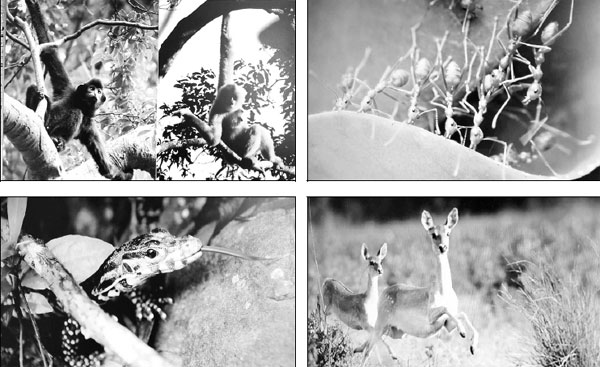
A number of rainforest animals photographed by Jiang. [Photos By Jiang Enyu/For China Daily]
"A male Hainan gibbon sits alone on the branch of a tall tree, looking up to the sky with a melancholy look, as if meditating deeply on its future." Photographer Jiang Enyu wrote this sentence as the caption for a photo of a Hainan gibbon in his book entitled Tropical Rainforests of Hainan Island.
Jiang spent six years capturing the mysterious fast-moving Hainan gibbons with his camera. Historically in large numbers on Hainan Island, the only habitat of Hainan gibbons, the species is now listed as critically endangered as the total population is thought to number just around 25.
"From 1997 to 2003, I went to Bawangling National Nature Reserve in central Hainan, the only habitat of Hainan gibbons, three or four times every year and slept in tents for more than 10 days every time in the mountains. I would get up early at about 4 am with the forest workers and we would climb up the mountain using flashlights, with food and drinking water in our bags, to search for traces of Hainan gibbons in an area of 300 square kilometers," said Jiang.
"At that time I began to keenly understand the meaning of the phrase "looking for a needle in a haystack," Jiang recalled.
Why did Jiang spent so much time trying to photograph the elusive the apes?
"Hainan gibbons are the iconic animal in the rainforests of Hainan, China's only tropical province, and finding them showed that the ecosystem in Hainan's rainforests was still intact," said Jiang.
"The value and significance of generating public awareness about the importance of its protection is beyond words. People know a lot about the endangered giant panda and the ibis, but not many know about Hainan gibbons, which are at much greater risk of extinction and thus need even greater care."
Jiang decided to focus his reporting on the protection of the island's rainforests and the local ecological environment when he moved from Qinghai province to work at the Hainan bureau of Xinhua News Agency in 1988, when the island was established as a province.
Hainan island, which makes up less than 0.5 percent of China' land area, harbors one-third of the country's bird and reptile species, and 4,600 or one-seventh of its plant species.
"I was amazed by the rich biodiversity of Hainan's rainforests. It was a magic world to me," said Jiang.
While learning from field books on botany and geography, Jiang also became true friends with a large number of forest workers and botanists, who gave him much support and led him to a better understanding of the ecosystems on the island.
Jiang became so fascinated with Hainan's rainforests that for the past 20 years he has been five to six times every year for stays of between a week and more than a month.
During these, Jiang noticed that some local practices were risking the sustainability of Hainan's rainforests. He was deeply impressed by the rich diversity of life in Yinggeling and became worried about the illegal hunting that was taking its toll on the wildlife. It was at his proposal that the Yinggeling National Reserve, the largest reserve in Hainan, was established in 2004.
Back in 1956, rainforests covered 8,600 sq kmof the island, but large-scale deforestation resulted in a dramatic loss and only 5,800 square kms remained when an island-wide logging ban was enforced in 1994.
Today, relatively untouched rainforests can only be found in the isolated mountains in remote areas and most of them are now protected as nature reserves, such as Wuzhishan, Yinggeling, Bawangling, Jianfengling, Biaoluoshan, Exianling, Limushan and Jiaxi.
"Unsustainable development remains a threat to these unique natural assets, which are fragile beneath their majestic appearance. The protection of the remaining rainforests is the biggest challenge facing us when developing tourism and related projects on the island," Jiang said.
"We human beings are only part of nature, not its master. To nature, the only thing we should give is respect, love and care," said Jiang.
His two books, published by the China Publishing House in 2011 and 2014, have been collected by a number of universities at home and abroad, and they also serve as reference books for rainforest workers and researchers.